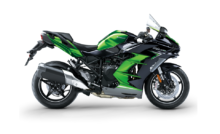2022 Kawasaki Vulcan 1700 Vaquero ABS Cooling System Owners Manual




2022 Kawasaki Vulcan 1700 Vaquero ABS Cooling System


Cooling System
Radiator and Cooling Fan
Check the radiator fins for obstruction by insects or mud. Clean off any obstructions with a stream of low-pressure water.
NOTICE
Using high-pressure water, as from a car wash facility, could damage the radiator fins and im- pair the radiator’s effectiveness. Do not obstruct or deflect airflow through the radiator by installing unauthorized accessories in front of the radiator or behind the cooling fan. Interference with the radiator airflow can lead to overheating and consequent engine damage.
Radiator Hoses
Check the radiator hoses for leakage, cracks or deterioration, and connections for leakage, or looseness each day before riding the motorcycle, and carry out the maintenance and adjustments in accordance with the Periodic Maintenance Chart.
Coolant
Coolant absorbs excessive heat from the engine and transfers it to the air at the radiator. If the coolant level becomes low, the engine overheats and may suffer severe damage. Check the coolant level each day before riding the motorcycle, also carry out the maintenance and adjustments in accordance with the periodic maintenance chart. Replenish coolant if the level is low. Change the coolant in accordance with the Periodic Maintenance Chart. Information for Coolant To protect the cooling system (con- Sisting of the aluminum engine and radiator) from rust and corrosion, the use of corrosion and rust inhibitor chemicals in the coolant is essential. If coolant containing corrosion and rust inhibitor chemicals are not used, over a period of time, the cooling system accumulates rust and scale in the water jacket and radiator. This will clog up the coolant passages, and considerably reduce the efficiency of the cooling system.
WARNING
Coolant-containing corrosion inhibitors for aluminum engines and radiators include harmful chemicals for the human body. Drinking coolant can result in serious injury or death. Use coolant in accordance with the instructions of the manufacturer. Soft or distilled water must be used with the antifreeze (see below for antifreeze) in the cooling system.
NOTICE
If hard water is used in the system, it causes scale accumulation in the water passages, and considerably reduces the efficiency of the cooling system.
If the lowest ambient temperature encountered falls below the freezing point of water, use permanent antifreeze in the coolant to protect the cooling system against engine and radiator freeze-up, as well as from rust and corrosion. Use a permanent type of antifreeze (soft water and ethylene glycol plus corrosion and rust inhibitor chemicals for aluminum engines and radiators) in the cooling system. On the mixture ratio of coolant, choose the suitable one referring to the relation between freezing point and strength directed on the container.
NOTICE
Permanent types of antifreeze on the market have anti-corrosion and anti-rust properties. When it is diluted excessively, it loses its anti-corrosion property. Dilute a permanent type of antifreeze in accordance with the instructions of the manufacturer.
NOTE
A permanent type of antifreeze is installed in the cooling system when shipped. It is colored green and contains ethylene glycol. It is mixed at 50% and has a freezing point of -350C (-3106.
Coolant Level Inspection
- Situate the motorcycle so that it is perpendicular to the ground.
- Check the coolant level through the coolant level gauge on the reserve tank. The coolant level should be between the F (Full) and L (Low) level lines.
NOTE
- Check the level when the engine is cold (room or atmospheric temperature).
- The reserve tank is located inside the left side cover.
B. L (Low) Level Line
C. Reserve Tank
If the amount of coolant is insufficient, add coolant (see Coolant Fill- ing section).
NOTE
ln an emergency you can add water alone to the coolant reserve tank, however it must be returned to the correct mixture ratio by the addition of antifreeze concentrate as soon as possible.
NOTICE
If coolant must be added often, or the reserve tank completely runs dry, there is probably leakage in the system. Have the cooling system inspected by your authorized Kawasaki dealer.
Coolant Filling
- Remove the seat (see seat section in the GENERAL INFORMATION chapter).
- Remove the bolt.
- Remove the left side cover by pulling out the cover out slowly to detach the projections.
B. Left Side Cover
C. Projections
Remove the cap from the reserve tank and add coolant through the filler opening between the F (Full) and L (Low) level lines.
B. Reserve Tank
C. Reserve Tank Cap
- Install the cap after filling coolant.
- Fit the projections of the cover into the holes of the frame side.
- Tighten the bolt.
B. Holes
C. Left Side Cover
Install the removed parts.
Coolant Change
Have the coolant changed by an authorized Kawasaki dealer.
Recent Posts
VW Jetta Engine Fuse Box Diagram
Access the comprehensive 2010-2018 VW Jetta Passenger Fuse Box Diagram to troubleshoot electrical issues effectively.…
VW Jetta Passenger Fuse Box Diagram
Explore the comprehensive VW Jetta Passenger Fuse Box Diagram to troubleshoot electrical issues effectively. Understand…
2023 Ford F-150 Lightning Fuse Box Diagram
Under Hood Fuse Box Location Remove the front luggage compartment cover. Under Hood Fuse Box…
2022 Kawasaki NINJA H2 SX SE Brake Lever Adjuster Owner’s Manual
2022 Kawasaki NINJA H2 SX SE Brake Lever Adjuster Owner's Manual NOTICE Only adjust the front…
2023 Land Rover Range Rover Evoque Exiting The Vehicle Owners Manual
2023 Land Rover Range Rover Evoque Exiting The Vehicle SINGLE LOCKING WARNING Before exiting the…
2023 Land Rover Range Rover Evoque Front Seats Owners Manual
2023 Land Rover Range Rover Evoque Front Seats FRONT SEAT SAFETY Make sure to read…
